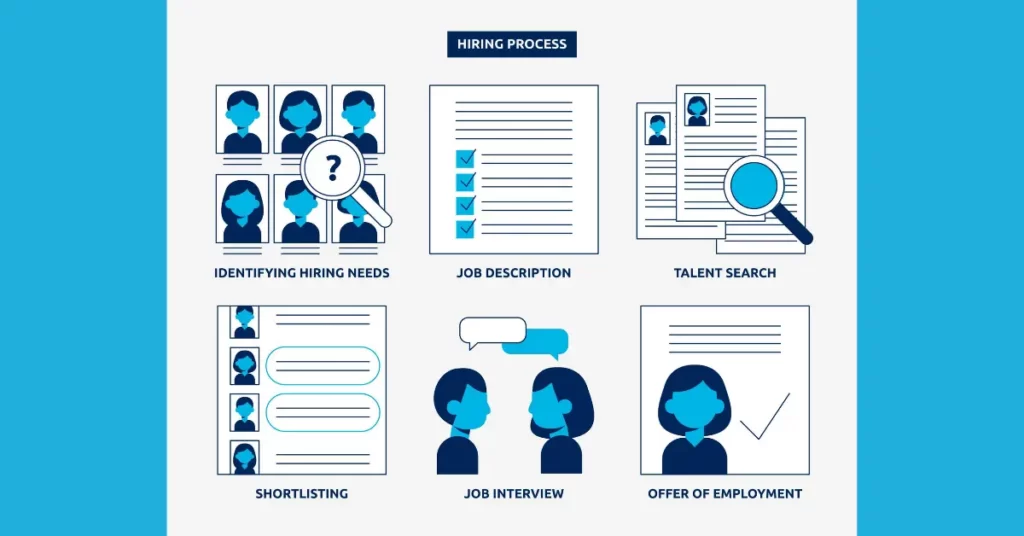Introduction
The field of human resource management is witnessing a paradigm shift with the recognition of the transformative power of effective recruitment and selection. In today’s fiercely competitive job market, HR managers face numerous challenges in attracting and retaining top talent. This article aims to delve into the core aspects of recruitment and selection that can revolutionize HR management, enabling organizations to build exceptional teams and drive unprecedented success.
The Foundations of Successful Recruitment
Defining the recruitment process in Human Resource Management
Effective recruitment requires a structured and well-defined process that encompasses various stages. From sourcing candidates to making the final offer, each step plays a crucial role in ensuring the selection of the most suitable candidates.
Setting goals and objectives for recruitment and selection
To achieve optimal outcomes, HR managers must establish clear goals and objectives for their recruitment and selection efforts. By aligning these goals with the overall HR strategy, organizations can create a recruitment and selection process that caters to their specific needs and long-term aspirations.
The link between recruitment and overall HR strategy
Recruitment and selection in Human Resource Management are intricately connected to the broader HR strategy. By identifying the organization’s strategic priorities, HR managers can effectively align recruitment practices with future organizational goals, ensuring a cohesive and forward-thinking approach.
Table of Contents
Job Analysis: Laying the Groundwork for Hiring Excellence

Identifying key job requirements and skills
A comprehensive job analysis is a fundamental step in the recruitment process. By identifying the job’s core requirements, HR professionals can determine the essential skills, qualifications, and experience necessary for success in the role.
Conducting comprehensive job analysis techniques
HR managers employ various techniques, such as interviews, job observations, and surveys, to gather detailed information about the job’s intricacies. These techniques aid in developing a thorough understanding of the position, allowing for accurate candidate assessment.
Analyzing job descriptions and specifications
Crafting accurate and persuasive job descriptions and specifications is crucial in attracting the right candidates. Through careful analysis of job requirements and an understanding of the organizational culture, HR managers can create appealing documents that resonate with potential applicants.
Crafting Attractive Job Advertisements
The art of writing compelling job postings
Crafting engaging job advertisements requires a combination of creativity and precision. Using captivating language and highlighting unique selling points, HR professionals can capture the attention of top talent and entice them to consider the opportunity.
Tailoring advertisements to attract top talent
To attract the most qualified candidates, HR managers need to tailor job advertisements according to the target audience. By aligning the ad’s content with the desired skills and experience, organizations can increase the chances of attracting exceptional talent.
Engaging with professional networks and job portals
Beyond traditional methods, HR professionals should actively engage with professional networks and job portals to expand their reach. Leveraging these platforms enables organizations to tap into a vast pool of potential candidates who may not be actively seeking employment but possess the desired skills and experience.
Sourcing Strategies: Expanding Reach and Accessing Hidden Gems
Leveraging social media platforms for recruitment
In today’s digital age, social media has emerged as a powerful tool for sourcing talent. HR managers can leverage platforms such as LinkedIn, Twitter, and Facebook to proactively reach out to potential candidates and create meaningful connections within the industry.
Exploring innovative sourcing techniques
Relying solely on traditional methods may limit an organization’s access to exceptional talent. By exploring innovative sourcing techniques, such as attending industry conferences or hosting recruitment events, HR professionals can discover hidden gems who possess unique skills and perspectives.
Building strong connections with industry influencers
Establishing strong relationships with industry influencers, thought leaders, and experts can significantly impact the sourcing process. Collaborating with these individuals not only expands the organization’s reach but also enhances its reputation, attracting potential candidates who value the endorsement of trusted industry figures.
Screening and Shortlisting: Filtering Out the Best

Developing effective screening methods
Efficient screening methods are fundamental in identifying the most qualified candidates. HR managers should employ a combination of techniques, including resume reviews, skill assessments, and pre-employment tests, to filter out individuals who possess the essential qualifications and align with the organization’s values.
Automating applicant tracking systems
To streamline the screening process, HR professionals can leverage applicant tracking systems (ATS). These technological tools automatically process and screen resumes, allowing for a more efficient and consistent evaluation of candidates, while also reducing human bias.
Streamlining the shortlisting process in HRM
Streamlining the shortlisting process ensures that HR managers can focus on the most promising candidates. By systematically reviewing applications and eliminating those that do not meet minimum requirements, organizations can save time and resources while maintaining a high standard of candidate evaluation.
Conducting Skillful Interviews
Preparing for successful interviews
Effective interview preparation involves developing a deep understanding of the job requirements, designing thoughtful questions, and identifying the desired candidate traits. HR managers should create an interview structure that allows for a comprehensive assessment of candidates’ skills, experiences, and cultural fit.
Implementing various interview formats
Employing a diverse range of interview formats, such as behavioral interviews, panel interviews, or technical assessments, enables HR professionals to gauge candidates from multiple perspectives. This comprehensive approach provides a more holistic evaluation and increases the likelihood of selecting the right candidate.
Evaluating candidates effectively
During the interview process, it is essential for HR managers to assess candidates objectively and fairly. By establishing clear evaluation criteria and utilizing rating scales, organizations can minimize bias and ensure that candidates are evaluated purely on their merit.
Assessing Potential: Psychometric and Aptitude Tests
Understanding the value of psychometric tests
Psychometric tests provide valuable insights into candidates’ personality traits, cognitive abilities, and work preferences. By incorporating these assessments into the selection process, HR managers can make more informed decisions and identify individuals who possess the necessary qualities for success in specific roles.
Implementing aptitude tests for accurate skill assessment
Apart from personality assessments, aptitude tests offer a standardized way to measure candidates’ specific skills and abilities. These tests provide a solid foundation for comparing candidates’ capabilities objectively and selecting those who demonstrate the highest potential.
Interpreting test results for effective decision making
Interpreting psychometric and aptitude test results requires expertise to derive meaningful conclusions. HR professionals should work closely with qualified professionals to ensure accurate interpretation and use the results as a reliable tool for decision making.
Reference and Background Checks: Unveiling the Truth

Conducting thorough reference checks
Reference checks provide crucial insights into candidates’ past performance, work ethics, and reliability. HR managers should conduct thorough reference checks to validate the information submitted by candidates and gain a comprehensive understanding of their previous achievements and behavior.
Verifying educational qualifications and credentials
Verifying educational qualifications and credentials is vital to ensure candidates possess the required academic background for the role. HR professionals should implement rigorous verification processes to validate degrees, certifications, and professional memberships to avoid any misrepresentation or deceit.
Detecting red flags through comprehensive background checks
Comprehensive background checks go beyond references and education verification to uncover any red flags or potential issues that may impact a candidate’s suitability for the role. These checks can include criminal records, credit history, and professional sanctions, allowing organizations to make more informed hiring decisions.
Making the Offer: Sealing the Deal
Negotiating job offers with selected candidates
Negotiating job offers requires effective communication and understanding of both the organization’s needs and the candidate’s expectations. HR managers should engage in open and transparent discussions to reach mutually beneficial agreements that meet both parties’ requirements.
Understanding employment law and regulations
Compliance with employment law and regulations is paramount throughout the offer process. HR professionals must have a comprehensive understanding of legal requirements, such as equal opportunity employment and minimum wage laws, to ensure adherence and avoid legal repercussions.
Onboarding strategies for successful integration
To facilitate a smooth transition for new hires, organizations should implement robust onboarding strategies. This includes providing necessary training, introducing new employees to the company culture, and assigning mentors who can guide them through the initial stages of their employment.
Recruitment Metrics and Analytics: Enhancing Decision Making
Identifying relevant recruitment metrics
Monitoring and measuring recruitment and selection metrics enable HR managers to evaluate the effectiveness of their strategies and make data-driven decisions. Key metrics may include time-to-hire, cost-per-hire, quality-of-hire, and applicant conversion rates.
Implementing analytics tools for data-driven insights
Employing analytics tools allows for the integration and analysis of recruitment data, providing HR professionals with actionable insights. By leveraging these tools, organizations can uncover patterns, inefficiencies, and areas for improvement within their recruitment processes.
Leveraging metrics to optimize recruitment processes in HRM
Using recruitment metrics to drive continuous improvement is essential for organizations aiming to thrive in the competitive talent landscape. Access to data enables HR managers to identify bottlenecks, refine strategies, and apply best practices, leading to more efficient and effective recruitment outcomes.
Building a Strong Employer Brand

Establishing a positive employer brand image
A positive employer brand attracts top talent and creates a competitive advantage for organizations. By developing a reputation for being a desirable employer through ethical practices, strong leadership, and employee-centric policies, HR professionals can position their organization as an employer of choice.
Showcasing company culture to attract talent
Transparently communicating the organization’s values, mission, and culture is instrumental in attracting candidates who align with those principles. Through various platforms, such as the company’s website, social media, and employee testimonials, HR managers can showcase their company’s unique culture and values to prospective employees.
Leveraging employee testimonials and success stories
Employee testimonials and success stories serve as powerful tools to demonstrate the organization’s positive work environment, career growth opportunities, and commitment to employee development. By sharing these stories, HR professionals can humanize the employer brand and leave a lasting impression on potential candidates.
Diversity and Inclusion: The Power of a United Workforce
Embracing diversity in recruitment efforts
Diversity and inclusion have become crucial aspects of modern workforce dynamics. HR managers should actively seek diversity in their recruitment efforts to foster creativity, enhance cultural competence, and create an inclusive work environment that embraces different perspectives and backgrounds.
Developing inclusive hiring practices
To ensure fairness and equal opportunities, HR professionals must develop inclusive hiring practices. This may involve reducing bias in job descriptions, implementing blind resume reviews, and adopting structured interview formats that minimize unconscious bias.
Fostering diverse teams for innovation and growth
Embracing diversity not only enhances organizational culture but also drives innovation and growth. Diverse teams bring together a wide range of experiences, ideas, and perspectives, fostering creativity and enabling organizations to solve problems more effectively while driving innovation in their respective industries.
Overcoming Recruitment Bias and Challenges
Recognizing unconscious bias in the selection process
Unconscious bias can unknowingly influence decision-making during the recruitment process. HR managers must proactively acknowledge and confront their biases, embracing diversity and implementing strategies to minimize its impact on candidate evaluation and selection.
Implementing strategies to reduce bias
To reduce bias, HR professionals can adopt strategies such as blind resume reviews, diverse interview panels, and structured interview formats. Additionally, training programs that raise awareness about unconscious bias can empower individuals to make fair and objective decisions.
Addressing challenges faced by HR professionals in recruitment
HR professionals encounter various challenges during the recruitment process in HRM, including talent shortages, increased competition, and changing candidate expectations. By staying informed about emerging trends, embracing innovative technologies, and employing flexible strategies, HR managers can overcome these challenges and attract top talent.
The Future of Recruitment and Selection in HRM: Embracing Technology
Exploring advancements in recruitment technology
The future of recruitment lies in embracing cutting-edge technologies. HR professionals should stay informed about emerging tools and platforms, such as artificial intelligence, machine learning, and automation, that can streamline and enhance the recruitment process.
The role of artificial intelligence in selection processes
Artificial intelligence (AI) holds tremendous potential in transforming recruitment and selection in HRM. AI-powered algorithms can analyze vast amounts of data, facilitate resume screening and candidate matching, and even predict a candidate’s potential fit within an organization, revolutionizing the way HR professionals make hiring decisions.
Preparing HR teams for future recruitment trends
To navigate the evolving landscape of recruitment, HR teams must actively prepare themselves. This includes investing in continuous learning and development, upskilling in areas such as data analytics and AI, and embracing a future-oriented mindset that embraces change and adapts quickly to emerging trends.
Conclusion
Strategic recruitment and selection in HRM have become game-changers for human resource management. By recognizing the significance of each step within the process, from job analysis to making the final offer, HR managers can successfully identify and attract the most qualified candidates. Implementing innovative sourcing strategies, leveraging technology, and fostering a diverse workforce are all integral to building exceptional teams that drive an organization’s overall success in the long run.
FAQS
1. How can effective recruitment & selection impact an organization’s success?
Effective recruitment & selection play a crucial role in an organization’s success. They ensure that the right candidates with the right skills and attributes are hired for the right positions. This leads to improved employee performance, higher productivity, lower turnover rates, and a more positive work culture. Ultimately, a strong workforce enhances the organization’s ability to achieve its goals and remain competitive in the market.
2. What are the most common challenges faced by HR managers during the recruitment and selection process? HR managers often encounter challenges such as:
- Talent Shortages: Difficulty in finding candidates with the required skills.
- High Competition: Competing with other companies for top talent.
- Unpredictable Factors: Candidate withdrawals, sudden changes in job market conditions.
- Bias and Diversity: Ensuring fair and unbiased selection while promoting diversity.
- Time and Resource Constraints: Balancing efficiency with thorough evaluation.
- Mismatched Expectations: Misalignment between candidate expectations and job reality.
3. How can employers attract top talent through innovative job advertisements?
Innovative job advertisements can attract top talent by:
- Showcasing Company Culture: Highlighting unique aspects of the company’s work environment.
- Using Engaging Formats: Utilizing videos, interactive elements, or creative graphics.
- Focusing on Impact: Describing the meaningful impact the role will have on the company.
- Including Growth Opportunities: Mentioning career advancement and learning prospects.
- Personalization: Tailoring job ads to specific target audiences.
4. What is the significance of conducting background checks on potential employees?
Background checks are important because they:
- Verify Information: Confirm the accuracy of a candidate’s claims.
- Mitigate Risks: Reduce the chances of hiring candidates with fraudulent or problematic histories.
- Ensure Safety: Protect the company’s employees, clients, and reputation.
- Maintain Trust: Assure stakeholders that due diligence is taken in the hiring process.
- Comply with Regulations: Meet legal requirements and industry standards.
5. How can HR professionals reduce unconscious bias in the recruitment process?
HR professionals can address unconscious bias by:
- Using Structured Interviews: Designing standardized interview questions for all candidates.
- Diverse Interview Panels: Involving individuals from diverse backgrounds in the evaluation process.
- Blind Resume Review: Removing identifying information from resumes during initial screening.
- Awareness Training: Educating staff about biases and their impact on decision-making.
- Data-Driven Approach: Analyzing recruitment data for potential bias trends.
5. What is the recruitment and Selection?
Recruitment & selection refer to the process of identifying, attracting, and choosing suitable candidates to fill job vacancies within an organization. It involves steps such as job analysis, sourcing candidates, screening applications, conducting interviews, assessing skills, and making final hiring decisions. The goal is to match the best-fit candidates with the organization’s needs and objectives.